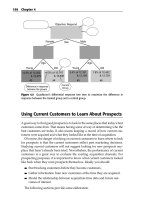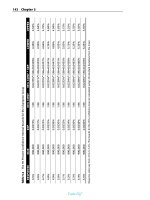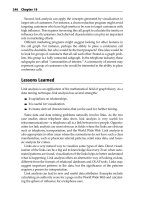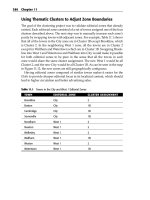John wiley sons mining graph data (2006) bbl 0471731900
Bạn đang xem bản rút gọn của tài liệu. Xem và tải ngay bản đầy đủ của tài liệu tại đây (7.02 MB, 502 trang )
MINING GRAPH DATA
EDITED BY
Diane J. Cook
School of Electrical Engineering and Computer Science
Washington State University
Pullman, Washington
Lawrence B. Holder
School of Electrical Engineering and Computer Science
Washington State University
Pullman, Washington
WILEY-INTERSCIENCE
A JOHN WILEY & SONS, INC., PUBLICATION
MINING GRAPH DATA
MINING GRAPH DATA
EDITED BY
Diane J. Cook
School of Electrical Engineering and Computer Science
Washington State University
Pullman, Washington
Lawrence B. Holder
School of Electrical Engineering and Computer Science
Washington State University
Pullman, Washington
WILEY-INTERSCIENCE
A JOHN WILEY & SONS, INC., PUBLICATION
Copyright c 2007 by John Wiley & Sons, Inc. All rights reserved.
Published by John Wiley & Sons, Inc., Hoboken, New Jersey.
Published simultaneously in Canada.
No part of this publication may be reproduced, stored in a retrieval system, or transmitted in any form
or by any means, electronic, mechanical, photocopying, recording, scanning, or otherwise, except as
permitted under Section 107 or 108 of the 1976 United States Copyright Act, without either the prior
written permission of the Publisher, or authorization through payment of the appropriate per-copy fee
to the Copyright Clearance Center, Inc., 222 Rosewood Drive, Danvers, MA 01923, (978) 750-8400,
fax (978) 750-4470, or on the web at www.copyright.com. Requests to the Publisher for permission
should be addressed to the Permissions Department, John Wiley & Sons, Inc., 111 River Street,
Hoboken, NJ 07030, (201) 748-6011, fax (201) 748-6008, or online at
/>Limit of Liability/Disclaimer of Warranty: While the publisher and author have used their best efforts
in preparing this book, they make no representations or warranties with respect to the accuracy or
completeness of the contents of this book and specifically disclaim any implied warranties of
merchantability or fitness for a particular purpose. No warranty may be created or extended by sales
representatives or written sales materials. The advice and strategies contained herein may not be
suitable for your situation. You should consult with a professional where appropriate. Neither the
publisher nor author shall be liable for any loss of profit or any other commercial damages, including
but not limited to special, incidental, consequential, or other damages.
For general information on our other products and services or for technical support, please contact our
Customer Care Department within the United States at (800) 762-2974, outside the United States at
(317) 572-3993 or fax (317) 572-4002.
Wiley also publishes its books in a variety of electronic formats. Some content that appears in print
may not be available in electronic formats. For more information about Wiley products, visit our web
site at www.wiley.com.
Library of Congress Cataloging-in-Publication Data
Mining graph data / edited by Diane J. Cook, Lawrence B. Holder.
p. cm.
Includes index.
ISBN-13 978-0-471-73190-0
ISBN-10 0-471-73190-0 (cloth)
1. Data mining. 2. Data structures (Computer science) 3. Graphic methods.
I. Cook, Diane J., 1963- II. Holder, Lawrence B., 1964QA76.9.D343M52 2006
005.74—dc22
2006012632
Printed in the United States of America.
10 9 8 7 6 5 4 3 2 1
To Abby and Ryan, with our love.
CONTENTS
Preface
xiii
Acknowledgments
xv
Contributors
1
INTRODUCTION
Lawrence B. Holder and Diane J. Cook
1.1
1.2
1.3
Part I
2
3
2
3
10
11
GRAPHS
15
Introduction
Definitions and Graph Matching Methods
Learning Edit Costs
Experimental Evaluation
Discussion and Conclusions
References
GRAPH VISUALIZATION AND DATA MINING
Walter Didimo and Giuseppe Liotta
3.1
3.2
3.3
1
Terminology
Graph Databases
Book Overview
References
GRAPH MATCHING—EXACT AND ERROR-TOLERANT
METHODS AND THE AUTOMATIC LEARNING OF EDIT COSTS
Horst Bunke and Michel Neuhaus
2.1
2.2
2.3
2.4
2.5
xvii
Introduction
Graph Drawing Techniques
Examples of Visualization Systems
17
17
18
24
28
31
32
35
35
38
48
vii
viii
CONTENTS
3.4
4
GRAPH PATTERNS AND THE R-MAT GENERATOR
Deepayan Chakrabarti and Christos Faloutsos
4.1 Introduction
4.2 Background and Related Work
4.3 NetMine and R-MAT
4.4 Experiments
4.5 Conclusions
References
Part II
5
6
7
Conclusions
References
MINING TECHNIQUES
DISCOVERY OF FREQUENT SUBSTRUCTURES
Xifeng Yan and Jiawei Han
5.1 Introduction
5.2 Preliminary Concepts
5.3 Apriori-based Approach
5.4 Pattern Growth Approach
5.5 Variant Substructure Patterns
5.6 Experiments and Performance Study
5.7 Conclusions
References
FINDING TOPOLOGICAL FREQUENT PATTERNS FROM
GRAPH DATASETS
Michihiro Kuramochi and George Karypis
6.1 Introduction
6.2 Background Definitions and Notation
6.3 Frequent Pattern Discovery from Graph
Datasets—Problem Definitions
6.4 FSG for the Graph-Transaction Setting
6.5 SIGRAM for the Single-Graph Setting
6.6 GREW —Scalable Frequent Subgraph Discovery Algorithm
6.7 Related Research
6.8 Conclusions
References
UNSUPERVISED AND SUPERVISED PATTERN LEARNING
IN GRAPH DATA
Diane J. Cook, Lawrence B. Holder, and Nikhil Ketkar
7.1 Introduction
55
57
65
65
67
79
82
86
92
97
99
99
100
101
103
107
109
112
113
117
117
118
122
127
131
141
149
151
154
159
159
ix
CONTENTS
7.2
7.3
7.4
7.5
7.6
8
GRAPH GRAMMAR LEARNING
Istvan Jonyer
8.1
8.2
8.3
8.4
8.5
9
Introduction
Related Work
Graph Grammar Learning
Empirical Evaluation
Conclusion
References
CONSTRUCTING DECISION TREE BASED ON CHUNKINGLESS
GRAPH-BASED INDUCTION
Kouzou Ohara, Phu Chien Nguyen, Akira Mogi, Hiroshi Motoda,
and Takashi Washio
9.1
9.2
9.3
9.4
9.5
9.6
10
Mining Graph Data Using Subdue
Comparison to Other Graph-Based Mining Algorithms
Comparison to Frequent Substructure Mining Approaches
Comparison to ILP Approaches
Conclusions
References
Introduction
Graph-Based Induction Revisited
Problem Caused by Chunking in B-GBI
Chunkingless Graph-Based Induction (Cl-GBI)
Decision Tree Chunkingless Graph-Based Induction
(DT-ClGBI)
Conclusions
References
SOME LINKS BETWEEN FORMAL CONCEPT ANALYSIS
AND GRAPH MINING
Michel Liqui`ere
10.1
10.2
10.3
10.4
10.5
10.6
10.7
Presentation
Basic Concepts and Notation
Formal Concept Analysis
Extension Lattice and Description Lattice Give
Concept Lattice
Graph Description and Galois Lattice
Graph Mining and Formal Propositionalization
Conclusion
References
160
165
165
170
179
179
183
183
184
185
193
199
199
203
203
205
207
208
214
224
224
227
227
228
229
231
235
240
249
250
x
11
12
13
CONTENTS
KERNEL METHODS FOR GRAPHS
Thomas G¨artner, Tam´as Horv´ath, Quoc V. Le, Alex J. Smola,
and Stefan Wrobel
11.1 Introduction
11.2 Graph Classification
11.3 Vertex Classification
11.4 Conclusions and Future Work
References
253
KERNELS AS LINK ANALYSIS MEASURES
Masashi Shimbo and Takahiko Ito
12.1 Introduction
12.2 Preliminaries
12.3 Kernel-based Unified Framework for Importance
and Relatedness
12.4 Laplacian Kernels as a Relatedness Measure
12.5 Practical Issues
12.6 Related Work
12.7 Evaluation with Bibliographic Citation Data
12.8 Summary
References
283
ENTITY RESOLUTION IN GRAPHS
Indrajit Bhattacharya and Lise Getoor
13.1 Introduction
13.2 Related Work
13.3 Motivating Example for Graph-Based Entity Resolution
13.4 Graph-Based Entity Resolution: Problem Formulation
13.5 Similarity Measures for Entity Resolution
13.6 Graph-Based Clustering for Entity Resolution
13.7 Experimental Evaluation
13.8 Conclusion
References
311
Part III
14
APPLICATIONS
MINING FROM CHEMICAL GRAPHS
Takashi Okada
14.1 Introduction and Representation of Molecules
14.2 Issues for Mining
14.3 CASE: A Prototype Mining System in Chemistry
14.4 Quantitative Estimation Using Graph Mining
14.5 Extension of Linear Fragments to Graphs
253
254
266
279
280
283
284
286
290
297
299
300
308
308
311
314
318
322
325
330
333
341
342
345
347
347
355
356
358
362
xi
CONTENTS
14.6
14.7
15
16
17
Combination of Conditions
Concluding Remarks
References
UNIFIED APPROACH TO ROOTED TREE MINING:
ALGORITHMS AND APPLICATIONS
Mohammed Zaki
15.1 Introduction
15.2 Preliminaries
15.3 Related Work
15.4 Generating Candidate Subtrees
15.5 Frequency Computation
15.6 Counting Distinct Occurrences
15.7 The SLEUTH Algorithm
15.8 Experimental Results
15.9 Tree Mining Applications in Bioinformatics
15.10 Conclusions
References
366
375
377
381
381
382
384
385
392
397
399
401
405
409
409
DENSE SUBGRAPH EXTRACTION
Andrew Tomkins and Ravi Kumar
16.1 Introduction
16.2 Related Work
16.3 Finding the densest subgraph
16.4 Trawling
16.5 Graph Shingling
16.6 Connection Subgraphs
16.7 Conclusions
References
411
SOCIAL NETWORK ANALYSIS
Sherry E. Marcus, Melanie Moy, and Thayne Coffman
17.1 Introduction
17.2 Social Network Analysis
17.3 Group Detection
17.4 Terrorist Modus Operandi Detection System
17.5 Computational Experiments
17.6 Conclusion
References
443
Index
411
414
416
418
421
429
438
438
443
443
452
452
465
467
468
469
PREFACE
Data mining, or knowledge discovery in databases, is a large area of study and is
populated with numerous theoretical and practical textbooks. In this book, we take
a focused and comprehensive look at one topic within this field: mining data that is
represented as a graph. We attempt to cover the full breadth of the topic, including
graph manipulation, visualization, and representation, mining techniques for graph
data, and application of these ideas to problems of current interest.
The book is divided into three parts. Part I, Graphs, offers an introduction to
basic graph terminology and techniques. In Part II, Mining Techniques, we take a
detailed look at computational techniques for extracting patterns from graph data.
These techniques provide an overview of the state of the art in frequent substructure
mining, link analysis, graph kernels, and graph grammars. Part III, Applications,
describes application of mining techniques to four graph-based application domains:
chemical graphs, bioinformatics data, Web graphs, and social networks.
The book is targeted toward graduate students, faculty, and researchers from
industry and academia who have some familiarity with basic computer science and
data mining concepts. The book is designed so that individuals with no background
in analyzing graph data can learn how to represent the data as graphs, extract patterns
or concepts from the data, and see how researchers apply the methodologies to real
datasets.
For those readers who would like to experiment with the techniques found in
this book or test their own ideas on graph data, we have set up a Web page for the
book at . This site contains additional information on
current techniques for mining graph data. Links are also given to implementations
of the techniques described in this book, as well as graph datasets that can be used
for testing new or existing algorithms.
With the advent of and continued prospect for large databases containing relational and graphical information, the discovery of knowledge in such data is an
important challenge to the scientific and industrial communities. Fielded applications for mining graph data from real-world domains has the potential to make
significant contributions of new knowledge. We hope that this book accelerates
progress toward meeting this challenge.
xiii
ACKNOWLEDGMENTS
We would like to acknowledge and thank the many people who contributed to this
book. All of the authors were very willing to help and contributed excellent material
to the book. The creation of this book also initiated collaborations that will continue
to further the state of the art in mining graph data. We would also like to thank
Whitney Lesch and Paul Petralia at Wiley for their assistance in assembling the
book and to thank the faculty and staff at the University of Texas at Arlington and
at Washington State University for their continued encouragement and support of
our work. Finally, we would like to thank our children, Abby and Ryan, for the
joy they bring to our lives and for forcing us to talk about topics other than graphs
at home.
xv
CONTRIBUTORS
Indrajit Bhattacharya University of Maryland
College Park, Maryland
Horst Bunke Institute of Computer Science and Applied Mathematics
University of Bern
Bern, Switzerland
Deepayan Chakrabarti Yahoo! Research
Sunnyvale, California
Diane J. Cook School of Electrical Engineering and Computer Science
Washington State University
Pullman, Washington
Walter Didimo Dipartimento di Ingegneria Elettronica e dell’Informazione
Universit`a degli Studi di Perugia
Perugia, Italy
Christos Faloutsos School of Computer Science
Carnegie Mellon University
Pittsburgh, Pennsylvania
Thomas G¨artner Fraunhofer AIS
Schloß Birlinghoven
Sankt Augustin, Germany
Lise Getoor University of Maryland
College Park, Maryland
David Gibson IBM Almaden Research Center
San Jose, California
Seth A. Grennblatt 21st Century Technologies, Inc.
Austin, Texas
Jiawei Han University of Illinois at Urbana-Champaign
Urbana-Champaign, Illinois
Lawrence B. Holder School of Electrical Engineering and Computer Science
Washington State University
Pullman, Washington
xvii
xviii
CONTRIBUTORS
Tam´as Horv´ath Fraunhofer AIS
Schloß Birlinghoven
Sankt Augustin, Germany
Takahiko Ito NARA Institute of Science and Technology
Ikoma, Nara, Japan
Istvan Jonyer Department of Computer Science
Oklahoma State University
Stillwater, Oklahoma
George Karypis Department of Computer Science & Engineering
University of Minnesota
Minneapolis, Minnesota
Nikhil Ketkar School of Electrical Engineering and Computer Science
Washington State University
Pullman, Washington
Ravi Kumar Yahoo! Research, Inc.
Santa Clara, California
Michihiro Kuramochi Department of Computer Science & Engineering
University of Minnesota
Minneapolis, Minnesota
Quoc V. Le Statistical Machine Learning Program
NICTA and ANU Canberra
Canberra, Australia
Giuseppe Liotta Dipartimento di Ingegneria Elettronica e dell’Informazione
Universit`a degli Studi di Perugia
Perugia, Italy
Michel Liqui`ere LIRMM
Montpellier, France
Sherry E. Marcus 21st Century Technologies, Inc.
Austin, Texas
Kevin S. McCurley Google, Inc.
Mountain View, California
Akira Mogi Institute of Scientific and Industrial Research
Osaka University
Osaka, Japan
Hiroshi Motoda Institute of Scientific and Industrial Research
Osaka University
Osaka, Japan
Melanie Moy 21st Century Technologies, Inc.
Austin, Texas
Michel Neuhaus Institute of Computer Science and Applied Mathematics
University of Bern
Bern, Switzerland
CONTRIBUTORS
Phu Chien Nguyen Institute of Scientific and Industrial Research
Osaka University
Osaka, Japan
Kouzou Ohara Institute of Scientific and Industrial Research
Osaka University
Osaka, Japan
Takashi Okada Department of Informatics
School of Science & Engineering
Kwansei Gakuin University
Sanda, Japan
Masashi Shimbo NARA Institute of Science and Technology
Ikoma, Nara, Japan
Alex J. Smola Statistical Machine Learning Program
NICTA and ANU Canberra
Canberra, Australia
Andrew Tomkins Google, Inc.
Santa Clara, California
Takashi Washio Institute of Scientific and Industrial Research
Osaka University
Osaka, Japan
Stefan Wrobel Fraunhofer AIS
Schloß Birlinghoven
Sankt Augustin, Germany
and
Department of Computer Science III
University of Bonn,
Bonn Germany
Xifeng Yan Department of Computer Science
University of Illinois at Urbana-Champaign
Urbana-Champaign, Illinois
Mohammed Zaki Department of Computer Science
Rensselaer Polytechnic Institute
Troy, New York
xix
1
INTRODUCTION
LAWRENCE B. HOLDER AND DIANE J. COOK
School of Electrical Engineering and Computer Science
Washington State University, Pullman, Washington
The ability to mine data to extract useful knowledge has become one of the most
important challenges in government, industry, and scientific communities. Much
success has been achieved when the data to be mined represents a set of independent
entities and their attributes, for example, customer transactions. However, in most
domains, there is interesting knowledge to be mined from the relationships between
entities. This relational knowledge may take many forms from periodic patterns of
transactions to complicated structural patterns of interrelated transactions. Extracting
such knowledge requires the data to be represented in a form that not only captures
the relational information but supports efficient and effective mining of this data and
comprehensibility of the resulting knowledge. Relational databases and first-order
logic are two popular representations for relational data, but neither has sufficiently
supported the data mining process.
The graph representation, that is, a collection of nodes and links between
nodes, does support all aspects of the relational data mining process. As one of
the most general forms of data representation, the graph easily represents entities,
their attributes, and their relationships to other entities. Section 1.2 describes several
diverse domains and how graphs can be used to represent the domain. Because one
entity can be arbitrarily related to other entities, relational databases and logic have
difficulty organizing the data to support efficient traversal of the relational links.
Mining Graph Data, Edited by Diane J. Cook and Lawrence B. Holder
Copyright c 2007 John Wiley & Sons, Inc.
1
2
INTRODUCTION
Graph representations typically store each entity’s relations with the entity. Finally,
relational database and logic representations do not support direct visualization of
data and knowledge. In fact, relational information stored in this way is typically
converted to a graph form for visualization. Using a graph for representing the data
and the mined knowledge supports direct visualization and increased comprehensibility of the knowledge. Therefore, mining graph data is one of the most promising
approaches to extracting knowledge from relational data.
These factors have not gone unnoticed in the data mining research community.
Over the past few years research on mining graph data has steadily increased.
A brief survey of the major data mining conferences, such as the Conference on
Knowledge Discovery and Data Mining (KDD), the SIAM Conference on Data
Mining, and the IEEE Conference on Data Mining, has shown that the number
of papers related to mining graph data has grown from 0 in the late 1990s to 40
in 2005. In addition, several annual workshops have been organized around this
theme, including the KDD workshop on Link Analysis and Group Detection, the
KDD workshop on Multi-Relational Data Mining, and the European Workshop on
Mining Graphs, Trees and Sequences. This increasing focus has clearly indicated
the importance of research on mining graph data.
Given the importance of the problem and the increased research activity in
the field, a collection of representative work on mining graph data was needed to
provide a single reference to this work and some organization and cross fertilization
to the various topics within the field. In the remainder of this introduction we first
provide some terminology from the field of mining graph data. We then discuss
some of the representational issues by looking at actual representations in several
important domains. Finally, we provide an overview of the remaining chapters in
the book.
1.1 TERMINOLOGY
Data mining is the extraction of novel and useful knowledge from data. A graph
is a set of nodes and links (or vertices and edges), where the nodes and/or links
can have arbitrary labels, and the links can be directed or undirected (implying
an ordered or unordered relation). Therefore, mining graph data, sometimes called
graph-based data mining, is the extraction of novel and useful knowledge from
a graph representation of data. In general, the data can take many forms from
a single, time-varying real number to a complex interconnection of entities and
relationships. While graphs can represent this entire spectrum of data, they are typically used only when relationships are crucial to the domain. The most natural
form of knowledge that can be extracted from graphs is also a graph. Therefore,
the knowledge, sometimes referred to as patterns, mined from the data are typically
expressed as graphs, which may be subgraphs of the graphical data, or more abstract
expressions of the trends reflected in the data. Chapter 2 provides more precise definitions of graphs and the typical operations performed by graph-based data mining
algorithms.









